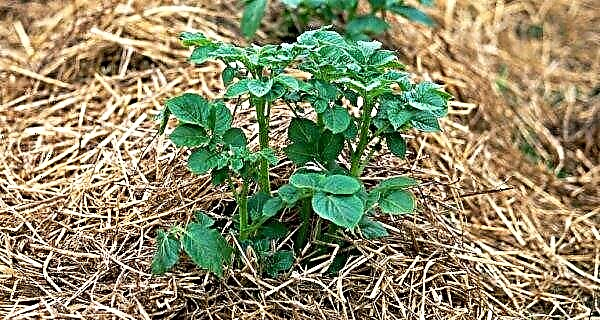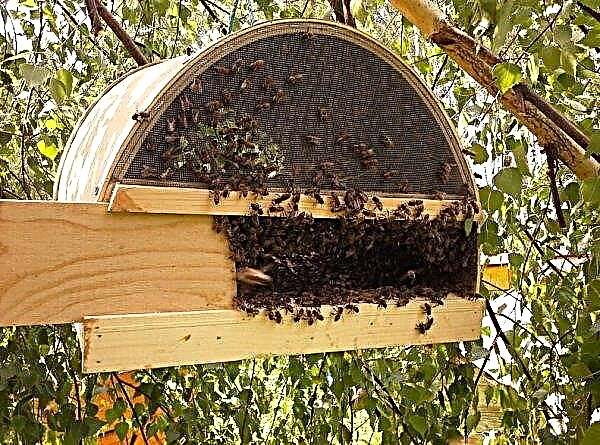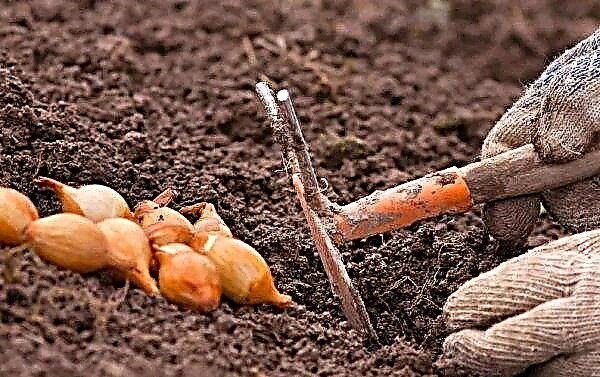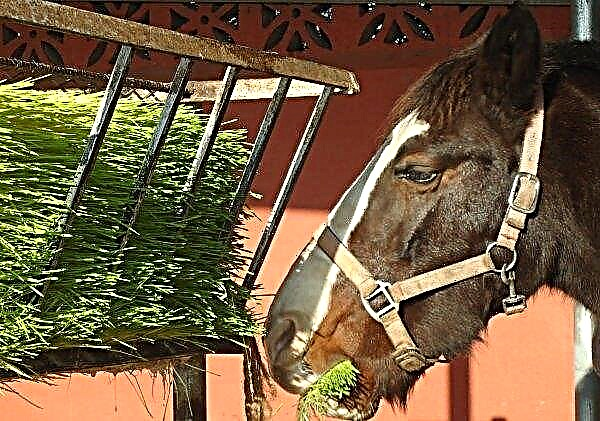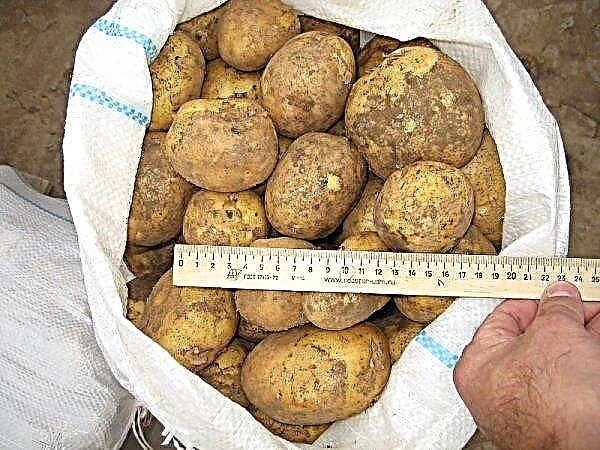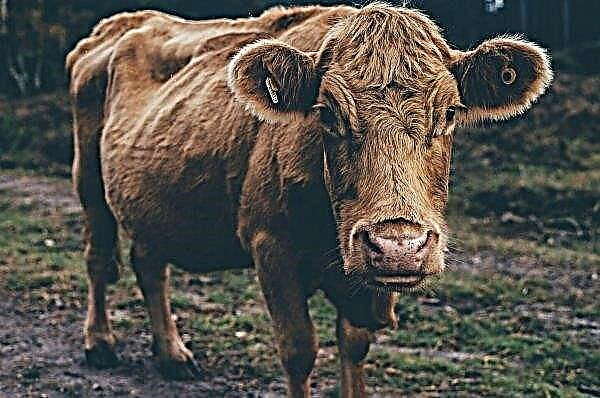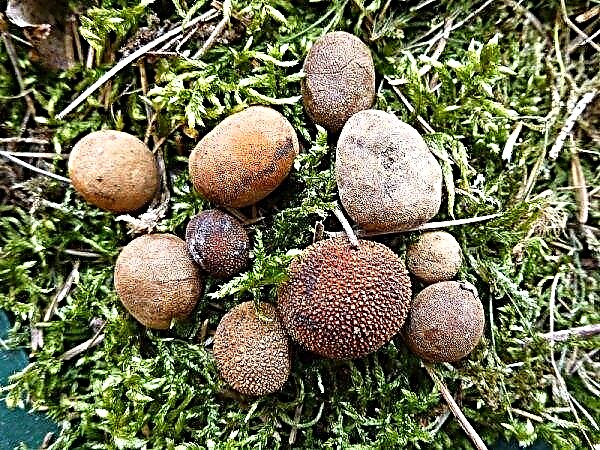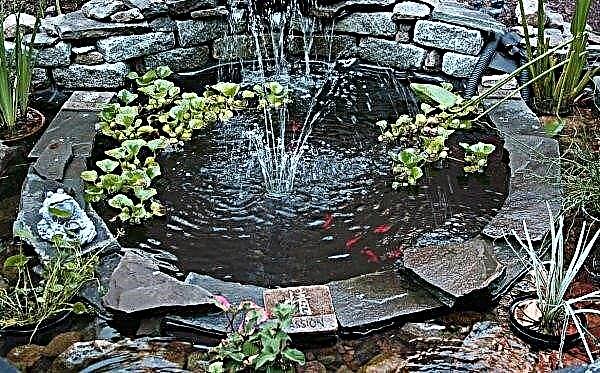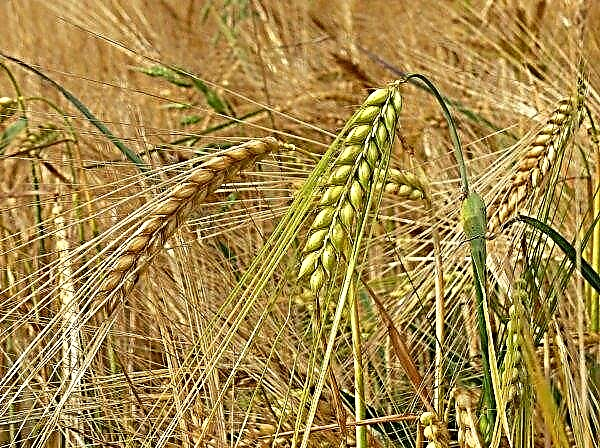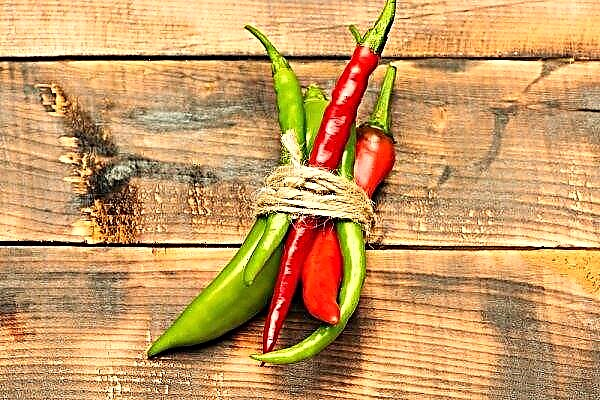Generous Redcurrant - one of the varieties of the "old" selection, bred in the USSR in 1949. Its distinguishing features - large red berries and high productivity brought him wide popularity among gardeners. In the article you will find a detailed description of the features of culture and its agricultural technology.
Description of the generous redcurrant variety
Although red currants, in our perception, stand next to black currants, in fact, they look more like gooseberries. Both plants tolerate moderately cold winters and can grow in the northern regions. Their fruits will ripen faster in the south and in bright sunlight. But currants are quite tolerant of growing conditions.
Did you know? Cultivated varieties of red currant were first started in France and Belgium in the 17th century.
Berries of red currant are considered more acidic than black. They can be consumed in kind, they are great for making sweet jam and various meat sauces.
Characteristic:
- self-pollinated;
- height - up to 1.8 m;
- width - up to 1.5 m;
- enters fruiting - 3-4 years after planting;
- blossoms - in May;
- matures - in late June or early July;
- fruiting regularity;
- lighting - bright sun;
- soil - loamy, well-drained, nutritious;
- drought tolerance - medium;
- winter hardiness - average;
- disease resistance - medium;
- productivity - high - 4-7 kg of berries from the bush.

Selection history
Generous - a variety of Soviet selection. Received at the Pavlovsk experimental station in 1949. It can be grown in the central regions of Russia, in the Urals and in the Northwest region. Obtained by crossing Faye and Houghton Castle. It is one of the most common early varieties in domestic gardens.
Appearance, characteristics of berries, ripening time, yield
The powerful bush Generous is characterized by medium growth power. In height, it does not exceed 1.8 m, but requires up to 1.5 square meters for growth, as they do not differ in compactness. It has thin, straight stems of gray color.
The size of the leaves is 4–7 cm. The opaque leaf plate slightly bends along the line of veins. Along the edge, it bends in a wave. Petiole leaf pubescent. Currant flowers are grouped in hanging clusters, not too large - up to 4-5 cm. The resulting fruits are small round berries of bright red color. In one bunch - up to 7 berries. Average weight - about 0.53 g. Taste - moderately sour, pleasant.
Redcurrant is rich in fiber, vitamins and minerals. But at the same time, it has very few calories. In 100 g of fruits, only 43 kcal, 0.6 g of protein, 0.2 g of fat and 7.7 g of carbohydrates. Berries have diuretic properties and are suitable for the treatment of influenza and other colds.
Advantages and disadvantages of the variety
- Grade advantages:
- self-fertility;
- high productivity;
- application: berries are suitable for juice, the manufacture of alcoholic beverages and high-quality jelly;
- early fruiting and winter hardiness make the variety convenient for growing even in the northern regions;
- low need for care.
- Disadvantages:
- does not tolerate temperature extremes, in such a situation fruit buds are damaged;
- medium resistant to anthracnose;
- prone to infection by the kidney tick.
Important! Black and red currants are recommended to be used during pregnancy and lactation. In addition to the presence of diuretic properties, berries strengthen the immune system and have a beneficial effect on the functioning of the respiratory system.
Agricultural technology
It is recommended to plant bushes of red currant in autumn or spring, if there is no threat of soil frost. When planting in spring, regular watering is mandatory 1-2 times a week during the first months after planting. At this time, moisture is needed to ensure intensive development of the root system.
If the bushes will be used as a hedge, you will need to plant them at a distance of 1 m (no closer) to each other. Otherwise, they will be too thickened, which contributes to the development of diseases. The plot must be selected sunny. Organic soil with good drainage should be preferred. Since usually in the soil there are not very many organic compounds (not higher than 5%), adding compost or rotted manure during planting will be a reasonable decision.
The plot must be selected sunny. Organic soil with good drainage should be preferred. Since usually in the soil there are not very many organic compounds (not higher than 5%), adding compost or rotted manure during planting will be a reasonable decision.
Seat selection and landing
Red currant grows in sunny areas. Since the buds of the bush can suffer from sudden changes in temperature during the cold season, from the north side the bushes should be protected by a cordon of trees or the wall of the building. It is also important to ensure the proper level of soil moisture.
Did you know? Currant fruits contain a significant amount of vitamin C, a powerful antioxidant that protects cells from damage by free radicals and, as a result, prevents early cell aging.
This is necessary for good rooting and fruiting. After all, berries consist of more than 82% water. If a seedling is purchased in a nursery, then most likely it is in a container. The size of the pit for its landing should be slightly larger than the size of the root ball. About 30 to 40 cm in length and width.
Landing Algorithm:
- The bush is planted in open ground in dry weather, when soil frost is not expected.
- At the bottom of the prepared pit, 0.5 compost buckets are laid. Another half a bucket is mixed with the soil removed from the recess.
- A support stake is installed in the pit, to which a seedling will be tied.
- Carefully remove the plant from the container and install it in the landing pit.
- Add soil mixture.
- Pour a bucket of water.
- Compact the soil around the trunk.
- Tie it with soft material to the support peg.

Care
Watering red currants should be regular. The volume of the crop depends on this. Start it in the spring. Spend at least 1 time per week. You can install drip irrigation for plants. This will allow better soil penetration in the root growth zone. Since plants do not tolerate cold water, drip irrigation allows water to quickly acquire soil temperature, reducing stress for plants from exposure to low temperatures.
A day after watering or rain, the soil must be loosened and weeds removed. The loose soil should provide oxygen access to the roots and give them room for development. As it grows, the bush uses nutrients that are in the soil. To make up for them, fertilizers are applied. But before you apply them, evaluate the condition of the bush. If it is fast-growing, with a large volume of leaf mass and powerful stems, then the culture does not need to be fed. A weakened plant with a small number of shoots must be fertilized. For this, nitrogen, phosphorus and potassium are needed. Nitrogen is responsible for the vegetative growth of the bush. It is part of urea and ammonium nitrate. It is introduced in early spring. The application rate is about 50 g per bush. During the formation of fruits, potassium and phosphorus are needed. Potassium provides the “correct” metabolic processes in plant tissues, and phosphorus is necessary for the formation of fruits and the development of the root system.
A weakened plant with a small number of shoots must be fertilized. For this, nitrogen, phosphorus and potassium are needed. Nitrogen is responsible for the vegetative growth of the bush. It is part of urea and ammonium nitrate. It is introduced in early spring. The application rate is about 50 g per bush. During the formation of fruits, potassium and phosphorus are needed. Potassium provides the “correct” metabolic processes in plant tissues, and phosphorus is necessary for the formation of fruits and the development of the root system.
The application rate is 40 g of each fertilizer. Inorganic substances can be replaced by organics. In this case, 4 kg of rotted manure is dissolved in a bucket of water and the bush is watered with this mixture in early spring, and in June, the same dose is applied again.
Some gardeners do not consider summer dressing necessary. But you should be guided by the appearance of your bushes when making a decision. In the fall, 1 liter of ash (a source of potassium) and 120 g of superphosphate for each bush are necessarily added. They can be dug into the soil or diluted with water and water the root zone.
Pest and Disease Control
Typically, currant bushes are well resistant to disease if they grow in suitable conditions - a sunny area, good air circulation, soil rich in fertilizers. Preventive treatment with 3% Bordeaux fluid in the spring before buds open up helps to avoid fungal diseases.
Did you know? About 190 species of currants grow on Earth, a significant amount of which grows in Siberia. Therefore, most cultivars have high frost resistance.
The main diseases affecting redcurrant:
- powdery mildew, manifested in the form of a velvety gray-white coating on the leaves;
- rust arising in the form of rusty spots on the underside of leaves.
Growing, infection leads to drying out and falling of leaves. When signs of infection appear, the bushes are again treated with Bordeaux liquid, but in 1% concentration, so as not to burn the leaves. Any copper based fungicide can also be used. As for pests, there are a lot of those who love berries. First of all, these are birds. Some species of birds even make nests in the currant bushes. There are many devices to scare them away. But according to gardeners, covering the bushes with a net that will not allow birds to get to the berries is much more efficient and cheaper.
As for pests, there are a lot of those who love berries. First of all, these are birds. Some species of birds even make nests in the currant bushes. There are many devices to scare them away. But according to gardeners, covering the bushes with a net that will not allow birds to get to the berries is much more efficient and cheaper.
Bushes are often attacked:
- Aphids - small insects that inhabit colonies on leaves. They are dangerous in that they damage the soft tissues of the plant and secrete sticky molasses, which becomes a medium for the propagation of sooty fungi and further infection of the shrub. To combat aphids, spraying bushes with a solution of insecticidal soap or treatment with "Fitoferm", "Biotlin". With severe infection, after 10 days (after the first), the treatment is repeated.

- Bud weevil - an insect that eats buds, flowers, leaves, which significantly reduces productivity. “Aktara” and “Mospilan” preparations are suitable for its destruction. From folk remedies, spraying bushes with infusion of needles or tobacco is used.
- Blackcurrant - a small golden bug, very dangerous for shoots. The insect gnaws at the stems, which leads to their death. To combat it, the affected branches are necessarily removed and the bushes are sprayed with a solution of Karbofos.

- Spider mite - It is an almost microscopic insect that settles on the underside of leaves. Signs of its appearance will be multiple small leaf damage and a small cobweb. To destroy the pest, spraying with Fufanon is used. If you plant marigold in the aisles, then its essential oils will scare away spider mites.
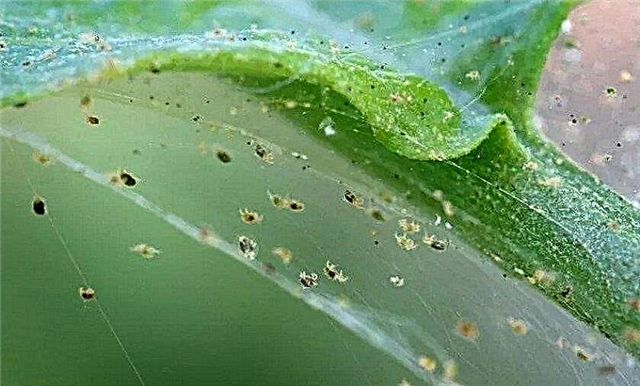
- Kidney tick, which, like the weevil, destroys any soft parts of the plant. Against this pest, currants are treated with BI-58 or Fosfamide preparations.
Video: how to deal with currant kidney mites
Trimming and shaping a bush
The optimal time for pruning a currant bush is February or March. The weather on this day should be dry and frost-free. Before work, the tool must be wiped with alcohol so as not to transfer microorganisms and disease spores from one plant to another.
Did you know? In the wild, red currants grow in the form of thickets. It is found on river banks and in humid shady deciduous forests.
Pruning algorithm.
- To get started, clean the center of the bush, because lighting is critical to both crop and disease prevention.
- Remove branches that interfere with each other, weave or tilt too low to the ground.
- Balance the bush so that it resembles a bowl in shape.
- Remove all branches older than 3 years. If they will bear fruit, then you will not get a good harvest on them.
 Fig. 1. Currant pruning: a - annual seedling; b - a biennial bush; c, d - shortening of shoots. Fig. 2. Currant bush before anti-aging pruning (a), after it (b) and pruning of a neglected bush (c).
Fig. 1. Currant pruning: a - annual seedling; b - a biennial bush; c, d - shortening of shoots. Fig. 2. Currant bush before anti-aging pruning (a), after it (b) and pruning of a neglected bush (c).Wintering
In winter, currants are at rest. But since her buds do not tolerate temperature extremes, it is advisable to cover the branches. Garden work on preparing for winter begins in the fall: weeds are removed and the garden is cleared of fallen leaves. Autumn intensive watering is carried out and fertilizers are applied (potash and phosphorus) in order for the bush to stock up on nutrients and moisture.
Then they dig a near-trunk zone in order to partially destroy pests prepared for hibernation. When the soil freezes, remove the branches from the supporting trellis, tie them with twine, lay on the ground and cover with a layer of mulch. It will protect the kidneys from sudden changes in temperature and humidity.
Harvesting and transportation of the crop, shelf life of berries
Generous is an early variety of currant. Harvest will ripen 40–45 days after flowering. Ripe berries acquire a bright red hue. If they mature, they soften. Therefore, they need to be collected when they are tight to the touch. You can store currants for no more than 5 days in a refrigerator at a temperature of about 0ºC and a relative humidity of 90–95%. To extend the shelf life, the fruits are picked early in the morning (while the berries are chilled). Red currants are too dense in texture. Therefore, it is collected in small plastic containers, designed for a weight of not more than 0.5 kg. This will protect the lower layer of the fruit from deformation. If you plan to transport the crop, then the berries are cooled to prevent mold.
Red currants are too dense in texture. Therefore, it is collected in small plastic containers, designed for a weight of not more than 0.5 kg. This will protect the lower layer of the fruit from deformation. If you plan to transport the crop, then the berries are cooled to prevent mold.
Generous is one of the most productive varieties of currant with good crop quality. When grown in a sunny area with fertile soil and good ventilation, you can minimize its disadvantages: average resistance to diseases and pests. The main thing is the observance of simple rules when growing varieties.




